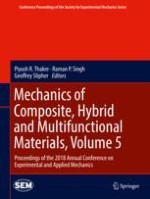2019 | Buch
Mechanics of Composite, Hybrid and Multifunctional Materials, Volume 5
Proceedings of the 2018 Annual Conference on Experimental and Applied Mechanics
herausgegeben von: Dr. Piyush R. Thakre, Dr. Raman P. Singh, Geoffrey Slipher
Verlag: Springer International Publishing
Buchreihe : Conference Proceedings of the Society for Experimental Mechanics Series
